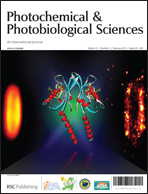Evaluation of the Hg2+ binding potential of fulvic acids from fluorescence excitation–emission matrices†
Abstract
The effect of Hg2+ on the fluorescence intensity of three fulvic acids (Pahokee Peat, Pony Lake and Suwannee River) was studied. The fluorescence intensity decreased in the presence of added Hg2+, while the fluorescence lifetimes were independent of the concentration of Hg2+ in solution. These results are indicative of ground-states association between the fulvic acids and Hg2+ with formation of stable non-fluorescent complexes (static quenching process). The analysis of the excitation–emission matrices with the Singular Value


 Please wait while we load your content...
Please wait while we load your content...